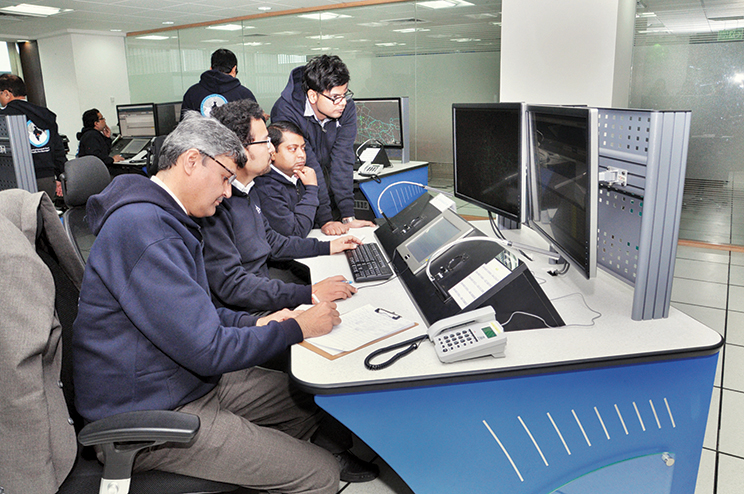ATFM
AIBM
April - June 2018
At any given time, only one aircraft can land or depart from a runway, and every aircraft must be separated with another aircraft or object by a certain distance or time to avoid collisions. Due to these factors every airport or airspace sector has a finite capacity; it can safely handle only so many aircraft per hour. This is known as Aerodrome Capacity or Airspace Capacity.
Aerodrome Capacity depends on many factors, such as the number of runways available, layout of taxi tracks, availability of air traffic control, and current or anticipated weather. The weather can cause large variations in capacity; strong winds may limit the number of runways available, and poor visibility may necessitate increases in separation between aircraft.
The variables that affect an Aerodrome Capacity are namely (1) Bad weather, (2) Change in Runway-in-use, (3) Runway configuration, (4) VIP movement, (5) Bird activity, (6) Unforeseen situation such as missed approach, (7) Necessitating Runway inspection for some reason and many more.
The Airport Runway Configuration is an important factor in deciding the Aerodrome Capacity. Different runway configuration has different capacities. For example, in IGI Airport (Delhi), if the westerly Runways are being used (i.e., Runways 27, 28, 29) the arrival capacity is approximately 37, but in case of easterly runways (Runways 09, 10, 11), the arrival capacity is approximately 32.
This declared Aerodrome Capacity is taken into account when allocating airport slots for arrivals and departures from the respective airport. However on the day of operations, invariably there are times when there are more arrivals than the airport can safely handle. When the air traffic demand reaches or exceeds the declared capacity, arriving aircraft are directed towards holding patterns where they circle until it is their turn to land. However, aircraft flying in circles is an inefficient and costly way of delaying aircraft, so it is preferable to keep them on the ground at their place of departure. This practice is called a ground delay program. This way, the delay can be absorbed on the ground with engines off, saving considerable amounts of fuel.
The application of such regulations in order to balance Capacity with air traffic demand is the function of Air Traffic Flow Management (ATFM) unit. It’s an activity that is done before flights take place.
Sophisticated computers are used by Air Traffic Flow Management to calculate exactly where an aircraft will be at any given moment and to predict when the demand of the airspace or airport is exceeding the declared capacity. This will help the ATFM managers to apply necessary regulations such as Ground delay.
Airports Authority of India (AAI) has implemented such an advanced state of art C-ATFM (Central ATFM) system called ‘Sky-Flow’. The C-ATFM system has started functioning since April 2017. India joins United States of America (US), Europe, Australia, South Africa, Brazil, Russia, Japan and China as one of the few countries that have implemented ATFM.
Objective of ATFM
Each airport and air traffic control sector has a published maximum capacity. When capacity is exceeded, measures are taken to reduce the traffic. This is termed regulation. The aim is to use capacity effectively, keeping the average delay as low as possible, while ensuring capacity is not exceeded.
As an example, if two flights are scheduled to arrive at an airport at exactly the same time, and the airport can handle one aircraft every five minutes, the aircraft may be assigned delays to ensure that the second aircraft arrives five minutes after the first. Similarly, the first aircraft will be required to depart on schedule and not allowed to depart late. This way, the second aircraft will not need to wait in the air.
In practice, the process is much more complex and highly computerised. One aircraft may be subject to several regulations at the same time. For example, a flight from Chennai to Delhi may be regulated both by limited capacity at Delhi as well as by limited capacity in Nagpur airspace.
In some cases, it may be possible to avoid delay by taking a different route. For instance, if Nagpur airspace was the only regulation for the flight in the previous example, changing the route to avoid Nagpur and going via Mumbai instead might allow a flight to depart without delay, although the route might be a bit longer.
Certain flights are exempted from regulation. For instance time-critical flights such as medical flights or VVIP flights. If such flights are scheduled, regular traffic will be delayed instead. If an airport is completely closed unexpectedly (for instance, because the only runway is blocked), a zero rate may be set for a certain time period (e.g. until the runway is expected to be reopened), which will cause all inbound flights to be issued a delay that will cause them to arrive after the reopening time. Flights already en route would either enter the holding or divert to an alternate airport.
Another example may be a delay in Cochin may be incurred because inclement weather is expected at the destination in Delhi, three hours later, even though the weather in Cochin is good and there is no congestion.
Benefits
- ATFM is a planning tool which helps to deliver optimum air traffic to airports with least average delay
- With the availability of ATFM regulations, the airlines will be able to predict the extent of delay and thus ensure predictability of operations
- The ATFM system will be able to assist and manage crisis situations such as airport runway closures, weather (floods, fog, etc.)
- ATFM monitors the entire national airspace and air traffic. Analysis of such vast data provides Airspace and Airport Planners a valuable tool for future infrastructure planning











